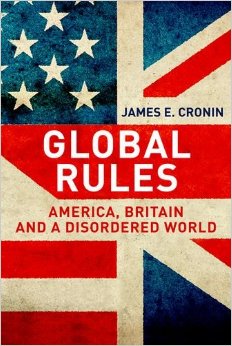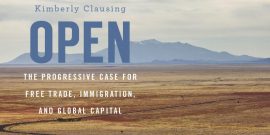The Queen’s Gambit is a feminist fantasy, with a chess prodigy forcing Cold War America to become woke sooner than it is ready.
A Common Bond
World War I shattered the nineteenth century global system that had brought an unparalleled expansion in trade and economic development. Globalization lurched into a dramatic reverse. George Kennan’s remark that World War I dramatically narrowed the options available to statesmen applied no less to merchants, financiers, and consumers. What became known as the “special relationship” between the Great Britain and the United States guided three efforts at refashioning a stable global economic order. The first attempt following World War I failed by the late 1920s, but Anglo-American cooperation after 1945 laid a foundation for prosperity across the free world. More recently and less remarked, a shared experience with crisis in the 1970s guided a post-Cold War economic settlement that revived globalization to pre-1914 levels. Rather than an anachronism, the Anglo-American special relationship underpins today’s world order.
Much has been written on the Washington Consensus of the 1990s that linked trade liberalization, regulatory transparency and market democracy. Along with a parallel emphasis on human rights, it set the dominant standard for international respectability. James Cronin in Global Rules: America, Britain, and a Disordered World explores how it emerged from contentious disputes in which one side prevailed and another lost. An earlier consensus that accepted greater regulation and state direction lost public authority when it stopped delivering prosperity. Britain and the United States faced especially acute challenges from “the apparent inability to control either the economy or the world outside.” The backlash encouraged a shift to market reforms that Margaret Thatcher and Ronald Reagan linked with uncompromising hostility to communism. A conceptual shift spread beyond Britain and the United States to set new global rules.
What made the Anglo-American partnership so pivotal? Necessity on both sides during World War II had brought the United States and Britain together, but frictions remained even then. Calculations of self-interest and relative power guided both sides. Rivalry persisted below the surface as the war’s course shifted. Britain’s decline made it seem less an asset for the United States during the 1950s, especially when financial constraints forced a military withdrawal a decade or so later. Differences over Korea, Suez and Vietnam generated friction. British figures who lost faith in their own country sought closer ties with a European Economic Community whose members had a stronger economic performance. Repudiating an Atlantic orientation marked a price of admission they willingly paid. In the early 1970s, the special relationship stood at its lowest ebb.
Important commonalities nonetheless persisted. Anglo-American personal ties had preceded the grand alliance Winston Churchill forged with Franklin Roosevelt. The late nineteenth century rapprochement that preceded America’s entry into World War I outlasted the vicissitudes of political fashion or changes in personnel. Central bankers in London and New York cooperated during the 1920s to stabilize international finance. Institutional ties that became closer after 1945 reinforced personal links and a sense of cultural similarity. James Baker’s aside that working with the British could be easy “because they’ve got the same paradigm, the same philosophy” captured a general feeling. Commonalities persisted alongside the divergence in the 1960s.
A stronger bond involved facing similar challenges that brought parallel responses in both countries after successive failures. Oil shocks and the end of the post war boom hit all developed economies, but Britain and the United States felt the consequences most sharply. Devaluing the pound under external pressure revealed structural weaknesses in Britain’s economy, while clashes with trade unions showed the difficulty of resolving them. Wage increases unions demanded and rising energy prices drove inflation that elicited calls for higher pay from groups with leverage over employers. The result was compressed living standards all around. The United States held a stronger position with the dollar as a global reserve currency, but inflation without growth fueled a sense of malaise. Richard Nixon and Gerald Ford performed no better than Jimmy Carter in handling pressures that overwhelmed the post-war consensus.
Standardized industrial production at high volume and mass consumption facilitated by generous wages underpinned a reformed capitalism that bought social peace over thirty years of growth. Corporatist bargaining among unions, large employers and the state benefitted the well-organized, but excluded small business and individual entrepreneurs along with voters as a whole. Standardization refashioned agriculture, retailing, and even education. Credentialed experts operating through large bureaucracies set rules and guided decision-making. Parties on the center left and right backed the managed economy, but stagnation gave critics an opening when respected experts lacked answers.
Even before Thatcher’s rise in Britain, the old consensus had become threadbare. James Callaghan, the Labor Party leader she defeated, realized the need to check union power and had bargained for time before strikes in 1979 brought down his government. Thatcher pressed a more sweeping market revolution than others would have envisioned, even if she proceeded more cautious in practice than rhetorically. Her rhetoric mattered in making a case that state direction of the economy had failed catastrophically. Only a return to market discipline could resolve the underlying problem. Albeit in a brighter tone, Reagan brought a similar critique that he had sharpened over his earlier career. The perspective Thatcher and Reagan articulated went from controversial to a conventional wisdom successors and opponents accepted as the new normal.
Anglo-American policies backed by a revived special relationship gained wider traction, particularly when France abandoned a brief experiment with socialism in the early 1980s. The decision by governments to act individually rather coordinate the management of economic crisis had opened a space for market reforms. Efforts by London and Washington to liberalize trade opened a separate front in spurring change. Petrodollars recycled from the Middle East as inflation ravaged Western economies promoted lending in other regions. The risks of default brought governments together in managing the Latin American debt crisis, but on different terms than before. A “silent revolution” in global finance rejected state direction over economic development for privatization and reliance on market incentives. Debt relief and access to capital depended upon accepting terms that later defined the Washington Consensus. The result embedded rules shaped largely by British and American perspectives within the global economy.
The revival of anti-communism and a hard line against the Soviet Union accompanied the market revolution, but with a new emphasis on democracy rather than defending capital and property. Cronin stresses the role of human rights, which the Soviet Union accepted during the 1970s in return for Western acknowledgment of European borders. What then seemed like an empty gesture opened fault lines within communist states. Promoting human rights through rhetoric and policy set a precedent that guided later standards for democratic practice as a political counterpart to the Washington Consensus.
Anglo-American cooperation sustained pressure on the Soviet Union that forced steps toward reform and eventual collapse. German unification, however, strained relations as Thatcher took a more suspicious view than George Bush and Baker who deftly managed the process. The failure of communism—both in practical and moral terms—ruled out alternatives to market democracy. Few, if any, in Central and Eastern Europe welcomed efforts to forge a social democratic or statist order. Atlantic rules spread into post-Communist Europe along with Western institutions. They provided a framework to bring post-communist states into the West. The Gulf War sparked by Iraq’s invasion of Kuwait ended the Cold War between the Soviet Union and the West while reviving Anglo-American ties strained by differences over German reunification. Military and diplomatic cooperation reinforced the ties of shared views on market economics and human rights to shape the emergent post-Cold War order.
A series of shocks from 2001 including wars in the Middle East and a financial crisis in 2008 that sparked what has been called the “Great Recession” have not substantially challenged the global rules of Anglo-American market democracy. Why? Cronin argues persuasively that the system has sufficient flexibility and openness to adapt. While democracy promotion has lost favor among British and American voters, no serious alternative exists to economic liberalism beyond fringe groups lacking wider appeal. Democratic electorates and authoritarian states largely accept the logic of market arguments. Examples of highly-regulated, managed economies in the Middle East like Egypt have little allure given the poverty and thwarted hopes accompanying them. Flexibility and the capacity to adapt remain at a premium.
Still the problems facing the global economy—and both Britain and the United States themselves—demand a response. How effectively can the paradigm Cronin describes provide it? Structural unemployment in developed countries imposes steep costs. The dominant role finance, real estate, and insurance have in Britain and the United States promotes value transference by the well connected over value creation by entrepreneurs. Financial crises fueled by reckless lending by banks and imprudent regulation by governments has also taken a toll. One need not embrace socialism or the managerial state to see that transferring risk from private speculators to the wider public has fostered a dangerous version of crony capitalism. If the old corporatist model that died in the 1970s and other discredited paradigms cannot answer these questions, market democracy must find solutions of its own. The special relationship faces another steep challenge. How effectively will it rise to the task?



